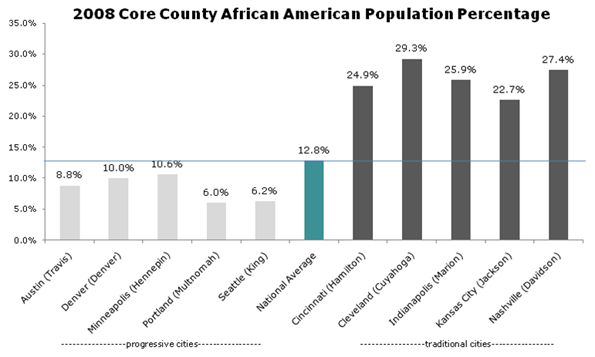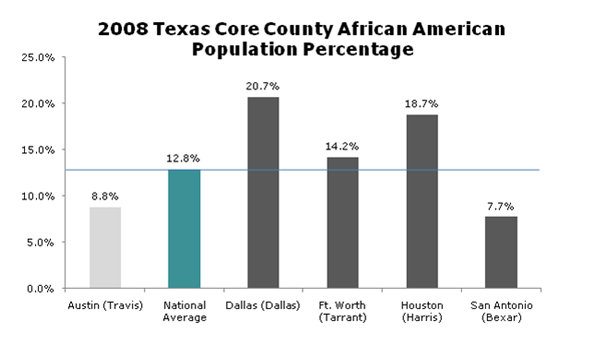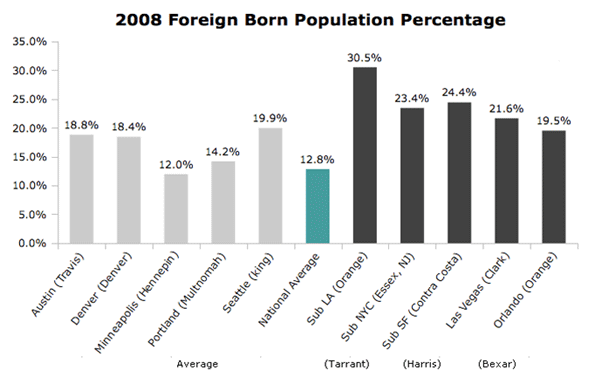
Among the media, academia and within planning circles, there’s a generally standing answer to the question of what cities are the best, the most progressive and best role models for small and mid-sized cities. The standard list includes Portland, Seattle, Austin, Minneapolis, and Denver. In particular, Portland is held up as a paradigm, with its urban growth boundary, extensive transit system, excellent cycling culture, and a pro-density policy. These cities are frequently contrasted with those of the Rust Belt and South, which are found wanting, often even by locals, as “cool” urban places.
But look closely at these exemplars and a curious fact emerges. If you take away the dominant Tier One cities like New York, Chicago and Los Angeles you will find that the “progressive” cities aren’t red or blue, but another color entirely: white.
In fact, not one of these “progressive” cities even reaches the national average for African American percentage population in its core county. Perhaps not progressiveness but whiteness is the defining characteristic of the group.

The progressive paragon of Portland is the whitest on the list, with an African American population less than half the national average. It is America's ultimate White City. The contrast with other, supposedly less advanced cities is stark.
It is not just a regional thing, either. Even look just within the state of Texas, where Austin is held up as a bastion of right thinking urbanism next to sprawlvilles like Dallas-Ft. Worth and Houston.

Again, we see that Austin is far whiter than either Dallas-Ft. Worth or Houston.
This raises troubling questions about these cities. Why is it that progressivism in smaller metros is so often associated with low numbers of African Americans? Can you have a progressive city properly so-called with only a disproportionate handful of African Americans in it? In addition, why has no one called these cities on it?
As the college educated flock to these progressive El Dorados, many factors are cited as reasons: transit systems, density, bike lanes, walkable communities, robust art and cultural scenes. But another way to look at it is simply as White Flight writ large. Why move to the suburbs of your stodgy Midwest city to escape African Americans and get criticized for it when you can move to Portland and actually be praised as progressive, urban and hip? Many of the policies of Portland are not that dissimilar from those of upscale suburbs in their effects. Urban growth boundaries and other mechanisms raise land prices and render housing less affordable exactly the same as large lot zoning and building codes that mandate brick and other expensive materials do. They both contribute to reducing housing affordability for historically disadvantaged communities. Just like the most exclusive suburbs.
This lack of racial diversity helps explain why urban boosters focus increasingly on international immigration as a diversity measure. Minneapolis, Portland and Austin do have more foreign born than African Americans, and do better than Rust Belt cities on that metric, but that's a low hurdle to jump. They lack the diversity of a Miami, Houston, Los Angeles or a host of other unheralded towns from the Texas border to Las Vegas and Orlando. They even have far fewer foreign born residents than many suburban counties of America's major cities.

The relative lack of diversity in places like Portland raises some tough questions the perennially PC urban boosters might not want to answer. For example, how can a city define itself as diverse or progressive while lacking in African Americans, the traditional sine qua non of diversity, and often in immigrants as well?
Imagine a large corporation with a workforce whose African American percentage far lagged its industry peers, sans any apparent concern, and without a credible action plan to remediate it. Would such a corporation be viewed as a progressive firm and employer? The answer is obvious. Yet the same situation in major cities yields a different answer. Curious.
In fact, lack of ethnic diversity may have much to do with what allows these places to be “progressive”. It's easy to have Scandinavian policies if you have Scandinavian demographics. Minneapolis-St. Paul, of course, is notable in its Scandinavian heritage; Seattle and Portland received much of their initial migrants from the northern tier of America, which has always been heavily Germanic and Scandinavian.
In comparison to the great cities of the Rust Belt, the Northeast, California and Texas, these cities have relatively homogenous populations. Lack of diversity in culture makes it far easier to implement “progressive” policies that cater to populations with similar values; much the same can be seen in such celebrated urban model cultures in the Netherlands and Scandinavia. Their relative wealth also leads to a natural adoption of the default strategy of the upscale suburb: the nicest stuff for the people with the most money. It is much more difficult when you have more racially and economically diverse populations with different needs, interests, and desires to reconcile.
In contrast, the starker part of racial history in America has been one of the defining elements of the history of the cities of the Northeast, Midwest, and South. Slavery and Jim Crow led to the Great Migration to the industrial North, which broke the old ethnic machine urban consensus there. Civil rights struggles, fair housing, affirmative action, school integration and busing, riots, red lining, block busting, public housing, the emergence of black political leaders – especially mayors – prompted white flight and the associated disinvestment, leading to the decline of urban schools and neighborhoods.
There's a long, depressing history here.
In Texas, California, and south Florida a somewhat similar, if less stark, pattern has occurred with largely Latino immigration. This can be seen in the evolution of Miami, Los Angeles, and increasingly Houston, San Antonio and Dallas. Just like African-Americans, Latino immigrants also are disproportionately poor and often have different site priorities and sensibilities than upscale whites.
This may explain why most of the smaller cities of the Midwest and South have not proven amenable to replicating the policies of Portland. Most Midwest advocates of, for example, rail transit, have tried to simply transplant the Portland solution to their city without thinking about the local context in terms of system goals and design, and how to sell it. Civic leaders in city after city duly make their pilgrimage to Denver or Portland to check out shiny new transit systems, but the resulting videos of smiling yuppies and happy hipsters are not likely to impress anyone over at the local NAACP or in the barrios.
We are seeing this script played out in Cincinnati presently, where an odd coalition of African Americans and anti-tax Republicans has formed to try to stop a streetcar system. Streetcar advocates imported Portland's solution and arguments to Cincinnati without thinking hard enough to make the case for how it would benefit the whole community.
That's not to let these other cities off the hook. Most of them have let their urban cores decay. Almost without exception, they have done nothing to engage with their African American populations. If people really believe what they say about diversity being a source of strength, why not act like it? I believe that cities that start taking their African American and other minority communities seriously, seeing them as a pillar of civic growth, will reap big dividends and distinguish themselves in the marketplace.
This trail has been blazed not by the “progressive” paragons but by places like Atlanta, Dallas and Houston. Atlanta, long known as one of America's premier African American cities, has boomed to become the capital of the New South. It should come as no surprise that good for African Americans has meant good for whites too. Similarly, Houston took in tens of thousands of mostly poor and overwhelmingly African American refugees from Hurricane Katrina. Houston, a booming metro and emerging world city, rolled out the welcome mat for them – and for Latinos, Asians and other newcomers. They see these people as possessing talent worth having.
This history and resulting political dynamic could not be more different from what happened in Portland and its “progressive” brethren. These cities have never been black, and may never be predominately Latino. Perhaps they cannot be blamed for this but they certainly should not be self-congratulatory about it or feel superior about the urban policies a lack of diversity has enabled.
Aaron M. Renn is an independent writer on urban affairs based in the Midwest. His writings appear at The Urbanophile.













You aren't better, you're just further
The point made in this article needs the widest possible dissemination. Aaron focuses on African Americans because their disadvantaged position creates huge challenges to economic development and urban renewal of the cities and counties where they are a politically significant minority. Hispanics have similar issues, but to a far lesser degree. Asians? Please. Ancestral diversity has no major consequences. The differences that matter are employable vs. unemployable and law-abiding vs. criminal.
A large portion of the African American population is completely disconnected from the economy and society. They don't see opportunity in regular work, so they have nothing to lose by turning to crime. This makes the carefree, walkable, friendly, clean neighborhoods that "progressives" love very difficult to create. You don't find Portland-style neighborhoods in St. Louis and Cleveland because it is not safe to be walking alone and waiting at bus stops with your laptop and iPod.
In white cities, "progressive," liberal, and Democrat means support for amenities like bike trails, libraries, museums, etc. In mixed cities, those words mean redistribution and patronage jobs. Basics like public schools, police protection, and public transit are redistribution because households with below-poverty income have little to tax. The low income minority-majority can raise taxes, and those taxes won't support services valuable to businesses or middle class households. Businesses and middle class households fear this. This is a major reason why our suburbs sprawl and our economies crawl.
I went to a hearing on preservation of a historic building. The black council members stood up and called for enforcement of the minority hiring rules for either the demolition crews or the rehabbing contractors. The building itself? They don’t care. How can they worry about aesthetics when their constituents are desperate for work?
To the white liberals who have moved from the major cities of the Midwest and the Northeast to the overwhelmingly white college towns, state capitals, and western cities: if you really cared about the less fortunate like you claim, you would be here, living with them, sharing their tax burden, spending money in their cities, and trying to create a place for them in the economy. You have run just like the people in the exurbs. Please quit publishing rankings with us at the bottom of “Smart Cities,” “Best cities for start-up,” and “Best cities for young singles.” Quit looking down on those of us trying to survive here.
Re: You aren't better, you're just further
This is an incredibly thoughtful response to the original post and effectively captures the sentiment that many of us not living in the aforementioned White Cities often feel. The posters who object to what is written here are conflating "white" with "no diversity"--possibly a fair conjecture given the nature of the argument and the way "White City" is bandied about among the discussion here like it's a pejorative. But these cities are not necessarily simply "white" so much as they are "non-black", which, as Anon here demonstrates, brings a host of different issues to the policymakers' tables than it would if the black population was only as large as the Asian population. And in some of these cities, the black population is actually smaller, which undoubtedly ranks these cities as demographic outliers.
Aaron, one other city that might fit into your categorization to a certain extent is Boston. While it is diverse by most metrics, and the white population hovers at I believe around 45%, the black population is significantly smaller than other eastern seaboard cities like Philadelphia, Baltimore, New York, and Washington. Even within New England, when compared to cities like New Haven, Bridgeport, or Providence, Boston's black population is comparatively small. Massachusetts as a whole has a lower percentage of African Americans than your average Rust Belt state, and Boston is the whitest city--or at least the most non-black--no, actually it is the whitest big city--in the East Coast.
Are you serious?
"To the white liberals who have moved from the major cities of the Midwest and the Northeast to the overwhelmingly white college towns, state capitals, and western cities: if you really cared about the less fortunate like you claim, you would be here, living with them, sharing their tax burden, spending money in their cities, and trying to create a place for them in the economy. You have run just like the people in the exurbs. Please quit publishing rankings with us at the bottom of “Smart Cities,” “Best cities for start-up,” and “Best cities for young singles.” Quit looking down on those of us trying to survive here."
Why just 'survive' anywhere. And share their tax burden...do you mean pay higher taxes so that they can go to public housing, daycare etc.? Sound temping out there to anyone? Nope. I didn't think so. To have a chunk of the population make the choice...and yes in this day and age it is more than a choice to be disconnected from the economy and society is a problem. It should not be tolerated. Particularly if this means they are a disproportionat drag to the rest of us. When did that become acceptable? Why is it acceptable that the language spoken by this disconnected group is unintelligable to outsiders?
Anon @ 11:11, Totally agree.
Anon @ 11:11,
Totally agree. Renn's article is one of the best I've read here.
That hip, progressive cities are basically full of white people and run for white people is a point that can't be made often enough.
Sure, Austin's white population may soon no longer be a majority but Austin will still be run by liberal white people who deal with the city's minorities on terms they control. That's really the thrust of Renn's piece, and let's not have quibbling about statistics and definitions of city v. county obscure that.
Cities where minorities are powerful local constituencies (the way they are in NY/Chi/LA) are never going to be progressive in the way white liberals prefer. With minorities able to dictate agendas, the most important local issues will be bread-and-butter economic, not lifestyle related. (Crime/cops may be the one are where there's some overlap.) Absent contracts and jobs, minority politicians don't give a damn about issues like light rail, arts funding, and as Anon mentioned, historic preservation.
Anon's right: Moving to Portland/Madison/Austin is no different from moving to Greenwich/Lake Forest. Just white folks going to places where they don't have to deal with the demands of minorities.
RE: by and for white people
"That hip, progressive cities are basically full of white people and run for white people is a point that can't be made often enough."
Okay, but this isn't really saying much, since there are very few cities run by non-white people for non-white people in the US. The examples you cite NY/Chicago/LA are our three largest cities and stand in a category all their own. And, incidentally, I'm no NY expert, but I think there are at least a few critics who might argue with you that "powerful local constituencies" have really been able to shape their own destinies there.
Dallas and Houston are run for white people every bit as much as Austin, with some significant ideological differences. I believe those differences really have nothing to do with the minority populations being fairly represented in either case.
RE: by and for white people
"Dallas and Houston are run for white people every bit as much as Austin, with some significant ideological differences."
Pardon? Are you talking about the Dallas with the two-term black mayor in the 90s? The one with a sitting black DA? The one with four black city council members?
Anyway, the response from the Austin fanboys here is not surprising. I've had this conversation with friends and family from Austin and people really flip out when their superiority complex is undermined by the statistically undeniable fact that Austin is a white enclave.
Only problem with your
Only problem with your statement is the statistics don't show that Austin is a white enclave. But I guess your obvious dislike of Austin allows you to overlook minor technicalities such as that fact. Don't hate the player, hate the game. It's not Austin's fault people have a negative view on the city of Dallas. Work to better your city, instead of trying to tear others down.
According to the Census
According to the Census 2005-2007 estimates, the whites comprised %63.7 (%34.2 "Latino of any race") population of Austin and African Americans %8.5. There are very few cities the size of Austin with that kind of disparity, especially in the South. In Dallas, those numbers are %55.9 whites (%42.4 Latino) and %23.3 African American. http://factfinder.census.gov/
By the way, I like Austin. I lived there for several years and started my career there. My wife was born there and several of my closest family members live there. However, I have always found it very strange that Austinites love one side of their cities' uniqueness, but are totally ignorant to the other things that makes Austin unique: the fact that it is small, uniformly middle-class and disproportionately white.
I posted demographics from
I posted demographics from the 2008 estimates showing Austin's White alone percentage of the population is 49.2% of the population. I might also add the city is 20% foreign-born. I don't know anyone who would consider a city with less than half it's population White to be disproportionately White.
It's also strange to consider a city of nearly 800,000 people to be small. Also, I don't know how being "uniformly middle-class" is a bad thing. However, the poverty rate in Austin for 2008 was 17%, so I'm not sure that would even be considered true.
http://austin.bizjournals.com/austin/stories/2009/09/28/daily15.html
http://factfinder.census.gov/servlet/ADPTable?_bm=y&-geo_id=16000US48050...
Austin is certainly more
Austin is certainly more diverse than Portland. I will give it that. But Austin is also the whitest major city in Texas. (It about equals Ft. Worth, depending on how you classify that). Here are the 2008 core county non-hispanic white only population percentages in Texas:
Austin (Travis): 53.2%
Dallas (Dallas): 35.5%
Ft. Worth (Tarrant): 54.2%
Houston (Harris): 36.0%
San Antonio (Bexar): 31.8%
Austin is about 20 percentage points whither than Dallas, Houston, or San Antonio even if you look at that stat directly.